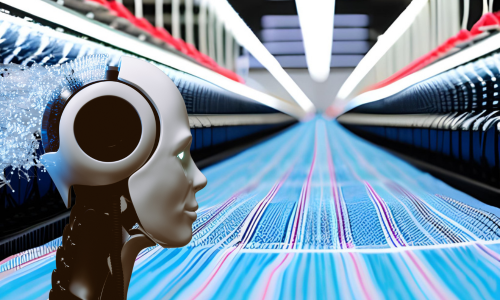The use of artificial intelligence in the textile industry
Editor02 WasetMasr أبريل 24, 2023

The use of artificial intelligence in the textile industry
The use of artificial intelligence in the textile industry is becoming increasingly popular. Artificial intelligence can be used to improve the efficiency of textile production, as well as to monitor and control the quality of materials used. AI can also be used to automate certain processes, such as tracking inventory, and predicting future trends in the industry. In addition, artificial intelligence can be used to reduce the amount of waste generated by the textile industry. The use of textile AI can be summarized in the following areas:
1.
Automated quality control and inspection using AI
AI systems with computer vision can detect defects and defects in textiles with much greater speed and accuracy than human inspectors. This can help improve quality and reduce waste. Companies like Amazon and AdeptMind are using AI for automated quality control.
2.
Predictive maintenance using artificial intelligence
Artificial intelligence algorithms can analyze data from sensors built into textile machines to predict the need for maintenance. This can help prevent equipment failures and reduce downtime.
3.
Improve product design using artificial intelligence
AI can analyze trends and customer preferences to help designers create new product lines to match existing styles and tastes. The AI design tools can also create new texture patterns and typography based on the input images. This can help speed up the design process. Companies like Anthropic and Catchoom are using artificial intelligence to design costumes. pre-design
4.
Design with artificial intelligence
Artificial intelligence is being used to help textile designers create new patterns and designs by analyzing large amounts of data and creating new designs based on that data. This can help designers quickly and efficiently create new and innovative designs, saving time and resources.
5.
Optimizing manufacturing with artificial intelligence
Artificial intelligence is helping to improve textile manufacturing in several ways. some examples
The AI can predict demand and optimize inventory levels for various textiles and dyes to reduce excess inventory.
AI can monitor equipment and machinery for signs of inefficiency or problems to reduce downtime.
AI can optimize factory floor planning and work scheduling to maximize productivity.
AI-powered robots take on tasks such as sorting, folding and wrapping textiles. Companies like SoftWear Automation and Sewbo are building AI-powered textile robots.
6.
Supply chain management using artificial intelligence
AI can help improve the textile supply chain by analyzing data on inventory levels, production schedules, and shipping times. This can help reduce costs and lead times.
7.
Personal experiences using artificial intelligence
Artificial intelligence enables more customized and personalized experiences for shoppers. By analyzing customer data, the AI can recommend custom clothing styles, sizes, and fit to individual shoppers. AI virtual stylists and clothing recommendation engines are becoming more and more popular. Companies like Stitch Fix and Bombfell are using artificial intelligence to provide customized design services.
8.
Determine personalization using artificial intelligence
Using artificial intelligence to customize textile products, such as apparel and home textiles, based on customer data and preferences. This can improve customer satisfaction and increase sales.
9.
Demand forecasting using artificial intelligence
Artificial intelligence algorithms analyze historical sales data and market trends to predict future demand for textile products. This can help companies improve production and inventory levels, reducing the risk of overstocking or understocking.
10.
Achieving sustainability using artificial intelligence
Using artificial intelligence to improve textile production processes and reduce waste and energy consumption. This can help companies reduce their environmental impact and become more sustainable.
11.
Customer service using artificial intelligence
AI-powered chatbots assist customers with their queries and provide personalized recommendations based on their preferences. This can help improve customer satisfaction and reduce the workload on customer service teams.
12.
Textile recycling using artificial intelligence
Using artificial intelligence to sort and classify textile waste, facilitating recycling and reuse. This can help reduce the amount of textile waste ending up in landfills and contribute to a more circular economy.